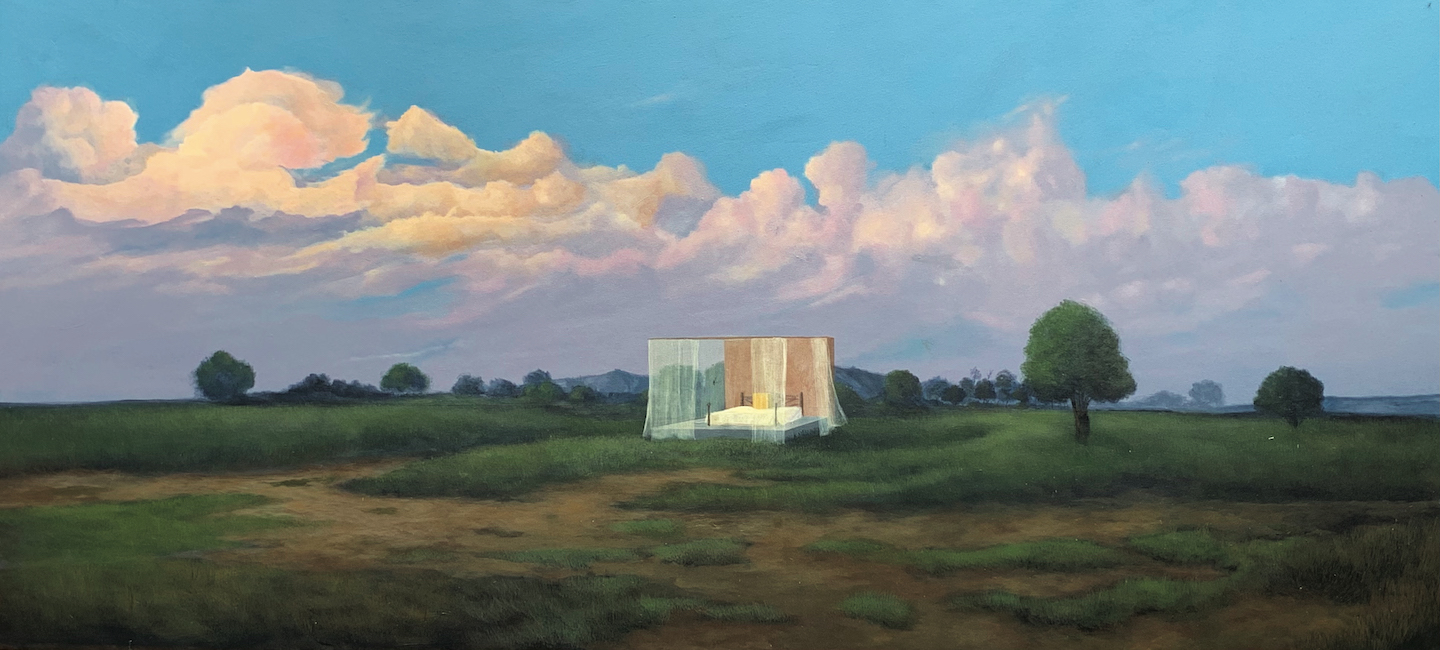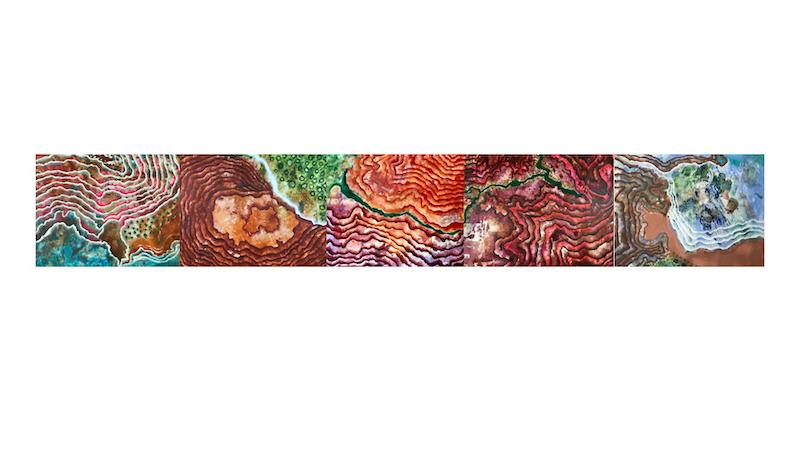
Home by Faiz Mahdon (All photos: Cult Gallery)
In its first exhibition for the year, Cult Gallery invites visitors to see things differently. Specifically, it aims to bring new perspectives through the eyes of seven young artists handpicked for their distinctive visual styles and concepts.
“These are artists on the cusp of becoming solo artists, who already have a strong visual language, identity, as well as a solid foundation in technical skills and conceptual thinking,” Suryani Senja Alias, founder and managing director of Cult, says of the artists featured.
“I want to introduce them not as one-off, one-piece-in-a-group-show kind of artists, but as artists already ripe to engage with the audience through their works. This show is to let them flex their muscles, as a prequel to solo exhibitions,” she adds.
The result is a rather substantial showcase, with over 40 works ranging from oil and acrylic paintings to mixed media, charcoal, pen and pencil drawings, gouache and sculptures. The exhibition’s title, 7 Ways of Seeing, which is also the curatorial theme, draws from a seminal book of essays by art critic John Berger, which, when published in the 1970s, challenged conventional perceptions about art and broke new ground for art criticism.
Drawing broadly from Berger’s subliminal message that there is not just one way to look at art, the show is as much a tentative exploration for the young artists as much as it is for those who may not have had the courage to immerse themselves in the visual arts world. It is an invitation for new audiences to engage and journey with a new generation of artists.
The notion of a “fresh eye” takes on literal form from the gallery’s entrance hallway itself, where a mesmerisingly detailed charcoal drawing of an eye greets us. The piece is by Kelantanese artist Ain Rahman, who renders the image of her own eye with photographic detail.
From here, subsequent pieces share a common thread rooted in human existence and experience. This does not take away from the fact that our individual experiences in life are what makes being human so colourful and unique. As Berger wrote, the way we see things are affected by what we know or even believe.
In a series of pointillism-like ink and pencil drawings, Amir Mansor offers a macro perspective, in the form of clusters of dots. Addressing the Covid-19 pandemic, Amir presents the idea of our existence and social movements from a “bird’s-eye view”.
art.jpg

One cannot help but examine this narrative beyond the pandemic, reflecting on the fragility and homogeneity of the human response when we are under threat or in fear, and how none of us is exempt — that we are all suddenly the same dots on a page, erasable like that of his pencil markings.
Sabahan artist Faiz Mahdon’s desolate yet immaculate landscapes delve into a very personal psychological and metaphorical realm. Apparently inspired by Freudian psychoanalysis theory, the works, devoid of human presence, nevertheless symbolise the isolating internal landscapes of his mind and being.
The odd objects dotting the surroundings evoke a sense of displacement and things being out of place, unnatural and bleak. Yet, like Amir’s works, there is the symbol of hope, here juxtaposed brightly in yellow (as a white dot in Amir’s works). But whether it is to be seen as an illusion, a clutch, or true hope is, of course, up to interpretation.
In contrast, Hana Zamri deals with her sense of displaced identity and belonging in a more expressive and somewhat journalistic way. In a series of acrylic and mixed media works, she creates the contours of landscapes from her memory of living in various countries while growing up, from Sudan to Croatia and China, to name a few.
Language is another element at play. “When I speak Malay, I forget my English, and vice versa. Then there’s French, which I write better than I speak. I think in all of these languages at various points,” shares the UiTM Master’s graduate.
She makes fun of the entanglements this sometimes gets her into in J’Oublie (2020), where she graffitied “Mati Pucuk = Mental Block”. “I actually was trying to think of the Malay phrase for mental block, which is mati kutu,” explains Hana with a laugh. Mati Pucuk, on the other hand, means erectile dysfunction.
Also collaged on the piece is the Ikrar Bahasa Kebangsaan, as well as a page torn from a 1960s book she found, in which the original owner had scribbled Chinese characters on top of some Malay words. “That is how I feel sometimes,” she illustrates.
trrain-page-001.jpg

But the issue of identity runs deeper and has more complex and nuanced connotations even amid a backdrop of increasing nationalism and racial segregation. The artist notes, “You know, I’ve had banana peels thrown at me in post-war Croatia, where they haven’t seen anyone like me before, have had people call me names. But I never felt so much racism as I did until I came back home for university. I never thought I’d have to try so hard to ‘belong’ in my own country, among people who look like me, who eat the same food as me, and speak the same language.”
The experience pushed her to escape into her own world. We see this theme in another piece, designed like a made-up map. This theme of continents and geography carries into her largest and latest work, which unlike the monochromatic tones of past works, is in full, vibrant colour.
Here, small figures of the artist herself are collaged onto various locations, partially hidden within the contours of each “continent”. If nothing else, one can see the transition from black and white to colour as a symbol of embracing her multi-faceted identity. It will be interesting to see where this meandering journey leads her next, artistically.
To draw a physical parallel with being comfortable in one’s skin, figurative painter Haz Yusup turns to nude paintings by the Italian Renaissance masters, such as Botticelli’s The Birth of Venus.
We see her homage to the genre in her intimate series of portrayals, though she says it bears the nuances of her 21st century female perspective, without the form’s typical religious or political undertones. Instead, Haz drew inspiration from Plato’s “Allegory of the cave” philosophy, where our perception is so influenced by things around us that we are blinded to or in denial of the truth.
By stripping all barriers from the physical self, the 28-year-old artist visually brings us back to nakedness perhaps as a way to see without distractions, to regain an intimate sense of self. “What this process has taught me most is about body language, of being comfortable with and accepting of ourselves, and to have courage.”
Mazlan Samawi’s plastic and bitumen sculptures and Nia Khalisa’s symbol-rich gouache prints round up 7 Ways of Seeing.
'7 Ways of Seeing' runs until April 12 at Cult Gallery, 10A Persiaran Bukit Tunku, KL. Viewing is by appointment only. Call (012) 415 8031 for more information.
This article first appeared on Apr 5, 2021 in The Edge Malaysia.


